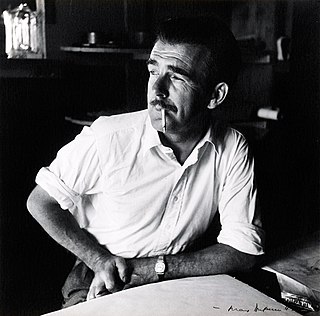
Sir William Dobell was an Australian portrait and landscape artist of the 20th century. Dobell won the Archibald Prize, Australia's premier award for portrait artists on three occasions. The Dobell Prize is named in his honour.

Grace Cossington Smith was an Australian artist and pioneer of modernist painting in Australia and was instrumental in introducing Post-Impressionism to her home country. Examples of her work are held by every major gallery in Australia.
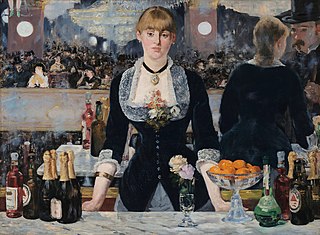
A Bar at the Folies-Bergère is a painting by Édouard Manet, considered to be his last major work. It was painted in 1882 and exhibited at the Paris Salon of that year. It depicts a scene in the Folies Bergère nightclub in Paris. The painting originally belonged to the composer Emmanuel Chabrier, a close friend of Manet, and hung over his piano. It is now in the Courtauld Gallery in London.

George Washington Thomas Lambert was an Australian artist, known principally for portrait painting and as a war artist during the First World War.
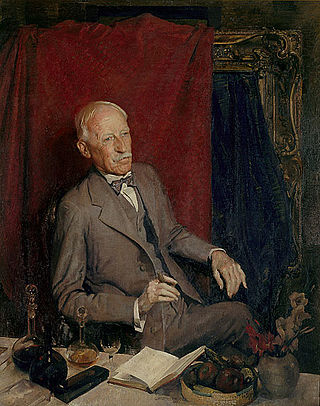
Julian Rossi Ashton was an English-born Australian artist and teacher. He is best known for founding the Julian Ashton Art School in Sydney and encouraging Australian painters to capture local life and scenery en plein air, greatly influencing the impressionist Heidelberg School movement.

Harold Pierce Cazneaux, commonly referred to as H. P. Cazneaux, was an Australian photographer; a pioneer whose style had an indelible impact on Australian photographic history. In 1916, he was a founding member of the Pictorialist Sydney Camera Circle. As a regular participator in national and international exhibitions, Cazneaux was unfaltering in his desire to contribute to the discussion about the photography of his times. His career between the Wars established him as "the country's leading pictorial photographer".
George Feather Lawrence (1901–1981) was born in Sydney, Australia and for many years was regarded as one of the foremost painters in the impressionist style. He studied under Julian Rossi Ashton at the famous Sydney Art School in the old Queen Victoria Building; and later in London and Paris.
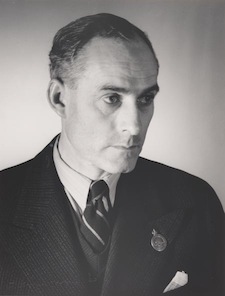
Adrian George Feint was an Australian artist. He worked in various media, and is noted for his bookplate designs.

Alethea Mary Proctor was an Australian painter, print maker, designer and teacher who upheld the ideas of 'taste' and 'style'.

Constance Stokes was an Australian modernist painter who worked in Victoria. She trained at the National Gallery of Victoria Art School until 1929, winning a scholarship to continue her study at London's Royal Academy of Arts. Although Stokes painted few works in the 1930s, her paintings and drawings were exhibited from the 1940s onwards. She was one of only two women, and two Victorians, included in a major exhibition of twelve Australian artists that travelled to Canada, the United Kingdom and Italy in the early 1950s.

Florence Ada Fuller was a South African-born Australian artist. Originally from Port Elizabeth, Fuller migrated as a child to Melbourne with her family. There she trained with her uncle Robert Hawker Dowling and teacher Jane Sutherland and took classes at the National Gallery of Victoria Art School, becoming a professional artist in the late 1880s. In 1892 she left Australia, travelling first to South Africa, where she met and painted for Cecil Rhodes, and then on to Europe. She lived and studied there for the subsequent decade, except for a return to South Africa in 1899 to paint a portrait of Rhodes. Between 1895 and 1904 her works were exhibited at the Paris Salon and London's Royal Academy.
Across the Black Soil Plains is a 1899 painting by Australian artist George Washington Lambert. The landscape depicts a team of draft horses pulling a wagon heavily laden with wool bales. Lambert's painting was awarded the Wynne Prize in 1899.

The Squatter's Daughter is a 1924 painting by Australian artist George Washington Lambert. It is part of the collection of the National Gallery of Australia in Canberra.

Weighing the Fleece is a 1921 painting by Australian artist George Washington Lambert. It is part of the collection of the National Gallery of Australia in Canberra.
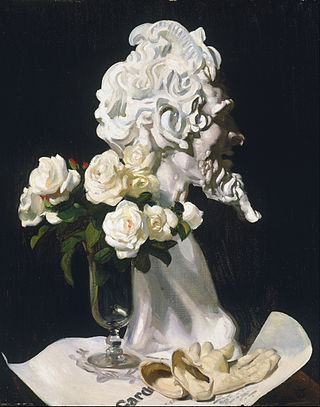
Pan Is Dead (Still Life) is a 1911 still life painting by Australian artist George Washington Lambert. The painting depicts "a sculpted head of Pan beside white gloves and a glass vase filled with white roses". Lambert created the bust of Pan as part of a costume for a character he played in a tableau vivant, The awakening of Pan, created in 1909 by the wife of the artist Philip Connard.
Lambert constructed a conceit in which he played upon the difference between how things appear on the surface of the canvas and how they are in reality. He abrogated the difference between the solid bust of Pan and the bunch of fragile white roses in the glass vase beside it by making the sculpted curls in Pan's hair resemble roses and by using sharply defined edges to 'sculpt' the flowers.
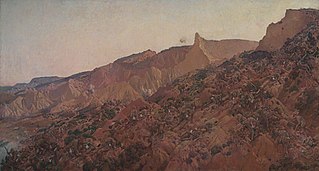
Anzac, the Landing 1915 is a painting by Australian artist George Washington Lambert, composed between 1920 and 1922. The painting depicts the landing at Anzac Cove by the Australian and New Zealand Army Corps on 25 April 1915 during the Gallipoli Campaign during World War I. The painting is part of the collections of the Australian War Memorial and "an active agent in promulgating one of Australia’s most dominant and enduring memories – that of the Gallipoli campaign."

Chesham Street is a 1910 oil on canvas painting by Australian artist George Washington Lambert. The work depicts a doctor performing an auscultation on a man with his shirt lifted and torso exposed. The work was painted at the Rossetti Studios on Flood Street in London. The painting is one of a set of "puzzle pictures" painted by Lambert between 1910 and 1914. These paintings are said to "appear to have a meaning and yet are not strictly narrative; they invite the viewer to provide their own interpretation.".
The man sits boldly in front of the viewer, holding up his shirt and revealing his entire torso. His head is held high, his lips are closed and he looks down at the viewer, seeming somewhat superior. His pale flesh, with the play of light on it, gleams against the dark surroundings.
Richard Stewart was an English stage actor who settled in Australia. He is best remembered as the father of Nellie Stewart.

Self-portrait with gladioli is a 1922 oil-on-canvas painting by Australian artist George Washington Lambert. The painting, a self-portrait, depicts Lambert in a brown velvet gown, wearing a purple scarf with a vase holding a gladioli in front of him.

Alfred Clint was an Australian cartoonist and theatrical scene painter and member of a notable family of artists.

















